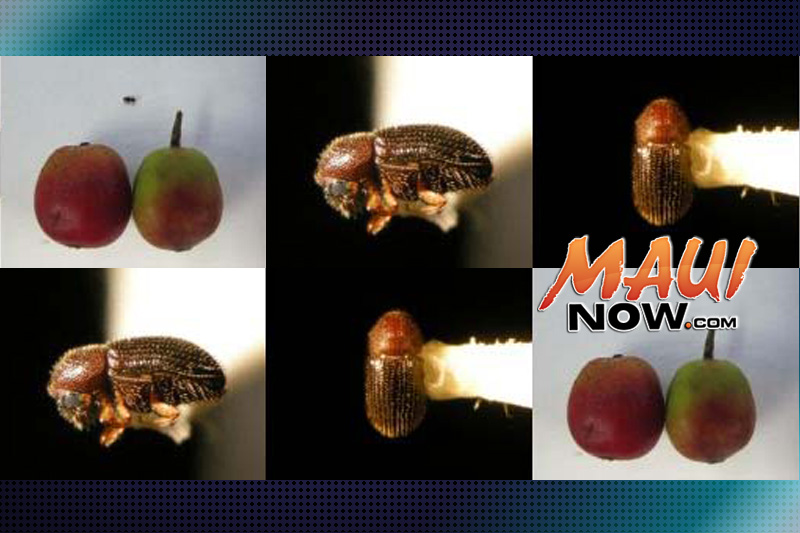Coffee Berry Borer Confirmed on Maui

Coffee Berry Borer. Images Courtesy Hawaiʻi State Department of Agriculture.
The coffee berry borer was detected in December 2016 on a coffee farm in Kīpahulu on Maui.
A neighbor of the 13-acre farm reported the possible CBB infestation to an extension agent at the University of Hawaiʻi, College of Tropical Agriculture and Human Resources on Maui.
Entomologists at the Hawaiʻi Department of Agriculture confirmed that it was CBB, a serious pest of coffee that was first detected in the state in Kona in 2010.
UH-CTAHR reports that the entire farm has been found to be infested with CBB, which indicates the infestation has been there for some time.
Earlier in November 2016, a resident in Hāna contacted HDOA about CBB in two backyard coffee trees. Those backyard trees were stripped of all coffee berries and fallen cherries have been collected and frozen to kill CBB. HDOA continues to monitor CBB traps at that site. Although the Kīpahulu farm and the Hāna residence are about 12 miles apart; it is not known if the two infestations are related.
HDOA surveys have been conducted in West Maui, ʻĪao Valley and Waikapū, and CBB has not been been detected in those areas.
HDOA’s Plant Quarantine Branch is also working on expanding quarantine protocol for movement of coffee plants and plant parts from Maui to uninfested areas.
“Despite strict quarantine rules that have been established on the interisland movement of coffee plants and plant parts from Hawaiʻi Island, CBB infestations have been extremely difficult to contain,” said Scott Enright, chairperson of the Hawaiʻi Board of Agriculture. “We ask that coffee growers continue to be vigilant and learn about CBB and how infestations can be detected and managed.”
2 Maui Workshops Planned on Jan. 9 in Kula:
UH-CTAHR, HDOA and the US Department of Agriculture will be holding two Maui workshops on Monday, Jan. 9, 2017 at the Kula Community Center, East Lower Kula Rd. to provide information to coffee farmers and other interested parties:
- 10 a.m. to noon: CBB 101 (General information on CBB)
- 5:30 to 7:30 p.m.: CBB Update (Information on CBB research and Integrated Pest Management (IPM) strategies)
Registration is required. Contact Gina at 808-322-4892 by Jan. 6, 2017. To view the workshop flyer with more information, go to: http://hawaiicoffee.weebly.com/2017-cbb-workshops.html
One of the most devastating coffee pests, CBB was first detected in the state in Sept. 2010 in Kona and discovered in Kaʻū in May 2011. In December 2014, it was discovered on Oʻahu.
This small beetle bores into the coffee “cherry” to lay its eggs. The larvae feed on the coffee bean, reducing the yield and quality of the bean.
Since its detection in Kona, Big Island coffee growers have developed methods to manage the pest, which include using an organic pesticide and field sanitation. Some farms with good management practices have been able to keep infestations down to about 20 percent of the coffee crop.
CBB is native to Central Africa and is also found in many coffee-growing regions of the world, including Central and South America. It is still unknown how CBB made its way to Hawaiʻi Island and how it came to Oʻahu.
Hawaiʻi has strict importation rules that require fumigation of all imported green coffee beans to rid the beans of pathogens and insect pests. Coffee plants and plant parts are also restricted from being imported to Hawaiʻi under Plant Quarantine rules.
In addition, HDOA issued a quarantine order that requires a permit from HDOA to transport unroasted coffee beans, coffee plants and plant parts, used coffee bags and coffee harvesting equipment from Hawaiʻi Island to other islands that are not infested with the coffee berry borer.
The rules also require certain treatments and inspection by HDOA Plant Quarantine inspectors prior to shipping. Inspectors will either attach a tag, label or stamp to indicate the shipment passed inspection requirements. For unroasted coffee beans, acceptable treatment protocols include fumigation, freezing and heat treatment.
For more information on CBB in Hawaii go to the HDOA CBB webpage at: http://hdoa.hawaii.gov/pi/ppc/cbbinfo/ and the UH-CTAHR webpage at: http://www.ctahr.hawaii.edu/site/CBB.aspx










